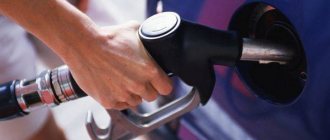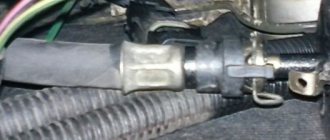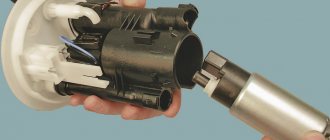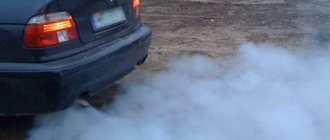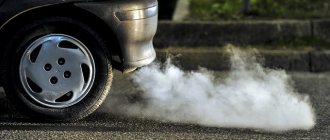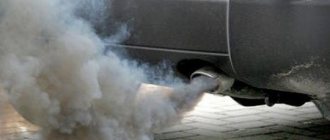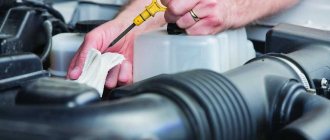If the cabin smells of gasoline when you start the engine, this is an alarm bell.
Let us note right away that there are many reasons why the smell of gasoline appears in the cabin when starting the engine. Among them there are both absolutely harmless (for example, supplying a rich mixture during a cold start) and alarming ones, for example, associated with a leaky fuel line. Only professional diagnostics will help determine the exact cause.
If you notice a smell in the cabin when starting a cold engine, then do not rush to worry. The fact is that when starting “cold,” the computer artificially enriches the mixture to make starting easier. Perhaps this is the only reason. However, it would be a good idea to inspect all hoses and connections of the fuel line for leaks. Start by checking the area under the car. Due to sudden temperature changes, pipes and hoses may crack. A fuel leak is accompanied by a characteristic “puddle”.
The presence of gasoline stains under the car indicates a leak.
Burning smell when starting the engine
If you smell a burning smell when starting the engine in cold weather, then first of all you need to determine the nature of the smell:
- sharp and caustic,
- sweetish,
- bitter, etc.
The sharp and acrid smell of burnt rubber indicates that pipes or seals are heating up somewhere in the engine compartment. A sweetish aroma indicates a leak of antifreeze onto a hot surface. The bitter smell is the smell of burnt motor oil. First of all, check the engine for leaks of technical fluids, and also make sure that no parts rub against hot elements - the exhaust system, exhaust manifold, etc.
Check all pipes for leaks, pay special attention to the tightness of the clamps
Note:
If you have technical problems with the Ford car brand - information!
Strong smell of gasoline when starting the engine
So, if when you start the engine you smell an unpleasant exhaust smell, the smell of gasoline or other odors, then there may be several reasons for this, which are listed in the table below.
| Cause | Description |
| Supply of rich mixture during cold start | If the smell goes away after some time, then most likely there is nothing wrong - the ECU simply supplies an enriched mixture for an easier cold start. |
| Injector malfunction | Accompanied by interruptions in fuel supply, engine tripping, and unstable starting. |
| Leaking fuel line | Increased fuel consumption, the presence of gasoline leaks, wet spots under the car - all this indicates a leak. The smell of gasoline lingers almost constantly. |
| Sensor malfunction | If the sensors give incorrect readings, the computer constantly supplies an enriched mixture. At the same time, the car loses power, the spark plugs quickly become covered with soot, and black or gray smoke is observed from the exhaust pipe. |
If the ECU supplies an over-rich mixture, this is invariably accompanied by a gray or black exhaust.
It happens that the driver smells oil when starting the engine. In this case, it is recommended to turn off the car and inspect the engine compartment. There is a high probability of engine oil leaking through the oil seals, oil filler plug, and dipstick shaft. Continued operation of the engine with constant oil leakage is extremely dangerous.
If you smell a strong oil smell when starting the engine, immediately turn off the engine and make sure there are no strong oil leaks!
LEAVE YOUR PHONE and we will contact you in 15 minutes
This problem, when the exhaust pipe smells of gasoline, haunts many car enthusiasts. Not only are everyone grown up and understands, gasoline is not something to joke about.
In addition to this problem, another nuisance is discovered - gasoline consumption increases. The first step when you discover these problems is to start an inspection from the hood to the gas tank.
There are often cases when the nut of the fitting for supplying the fuel line to the carburetor becomes loose, and the radiator fan blows gasoline vapors back to the muffler.
Next, you should go to the inspection hole and carefully inspect the entire path of gasoline from the gas tank
to the carburetor or injectors if you have an injection engine. All fittings and clamps on the connecting hoses of the fuel line should be tightened along this path.
There are often cases when on domestic cars, after just 3-4 years of operation, the walls of the gas tank resemble a sieve (the article "?" will immediately help). If, through inspection, you do not find any traces of gasoline leaks, then you should move on to a more in-depth study of this problem.
The alarm system is faulty
Car alarms, like all electronic systems, are subject to failures:
- triggers randomly;
- does not set the car alarm;
- blocks disarming via the original key fob.
Finally, electronics sometimes prevent the car from starting. The reasons are as follows:
- the alarm wiring or its power line is faulty;
- The anti-theft device (immobilizer) does not work;
- they tried to steal the car;
- there was a problem in the program.
Sometimes the driver himself forgets to remove the car from the security system, which includes an ignition interlock. Remove the protection and start the engine.
To check whether the cause is really an alarm failure, pay attention to the following signs:
- The alarm indicator light does not flash as usual;
- the security system is disarmed, but the key fob still displays a message about the ignition switch being closed;
- The sound of the siren does not turn off, the light alarm goes off;
- buttons do not work correctly;
- The central unit does not respond to signals from the key fob.
Try resetting the alarm to factory settings via the key fob. The procedure is described in the instructions, which it is recommended to always keep in the glove compartment. If you don’t have it at hand, download it from the Internet.
If the central unit does not respond to key fob presses, reset by pressing the secret button - VALET. Most often, the VALET button is hidden under the dashboard or in other hidden places. Turn the ignition on, off and on again. Then press the secret button three times. Some systems require you to enter a PIN code.
Common motor problems
Does the exhaust pipe smell of gasoline and do you feel uncomfortable driving your car? The first step is to determine in which specific cylinder the fuel does not burn and is carried further along the exhaust manifold. A spark plug that is wet or has a greasy appearance than others will show you the main location of the gasoline leak.
If all the candles are evenly greased
, then open the oil filler neck and look at the condition of the oil and the presence of light brown foam on the neck cap. This foam indicates that because , the entire combustible mixture does not burn and fuel particles are carried away into the exhaust pipe.
If you have a compression gauge, this is easy to determine.
There are often cases
when the chamfer of one exhaust valve in the combustion chamber gradually burns out and through it the gasoline-air mixture constantly breaks into the exhaust pipe. An experienced mechanic will help eliminate gasoline leakage in it.
{banner_content} It is necessary to replace the piston rings, valves, and in advanced cases, the aluminum pistons themselves. That is, you are guaranteed an average engine repair. And yet, you shouldn’t rush into repairs at first.
Not everything is so bad
. A loose cap on the spark plug or a high-voltage spark plug wire with a breakdown will cause the spark plug to work intermittently, which will allow gasoline to flow freely into the exhaust manifold.
But don’t be alarmed if you see some kind of liquid pouring out of the muffler in a stream or drop by drop; this is not gasoline, but steam condensation that forms on the cold walls of the muffler when the engine starts. Although condensation can also smell like gasoline.
Candles
Another reason is spark plugs filled with gasoline, whose job is to ignite the fuel. If the elements are installed a long time ago, they gradually become dirty. Each automaker specifies the intervals for checking and replacing spark plugs in the maintenance schedule. In addition, the necessary information is indicated in the service book or in the vehicle’s operating manual.
Spark plug flooded with gasoline
When the driver tries repeatedly and unsuccessfully to start the car, the spark plugs become heavily flooded with gasoline. After that they definitely won't work anymore. To correct the situation, unscrew and dry them.
Candles can also be filled on a carburetor engine. But the described situation is especially relevant for modern cars with electronic injection, when the driver unknowingly begins to repeatedly press the gas pedal, which in this case only causes harm.
Injection problems
If you have a modern fuel-injected car, but the smell from the muffler appears like that of an old Volga
, therefore the fuel is re-enriched. One of the reasons for this is. Also on injection machines there is a valve that regulates the discharge of unused gasoline back into the gas tank. If it fails, the combustible mixture will be greatly over-enriched.
A faulty air mixture sensor creates the same problem. An experienced auto electrician will quickly fix these problems.
Do you have a modern car, but have you noticed that the exhaust pipe smells of gasoline? There is no need to panic, there is an explanation for this. A catalyst is installed in the exhaust pipe, which is required to clean and burn harmful substances and gasoline vapors found in the exhaust gases. But until the catalyst heats up to a temperature of 250°C, it does not clean anything.
Its operating temperature is 600-800°C
. That’s why Western experts recommend driving as soon as the car starts, so that the catalyst warms up faster.
Additionally, you should know that the lambda probe has practically no effect on a not warmed-up car. Therefore, the first minutes after starting the engine there is always an over-enriched mixture, which entails the smell of unburnt gasoline. After the car warms up, this unpleasant effect disappears.
This problem worries many motorists, because they are well aware that gasoline is not something to joke about. But another nuisance is added to this problem - fuel consumption increases. If such a problem is discovered, then the first thing to do is inspect the entire car body from the hood to the fuel tank. Sometimes it happens that the nut of the fitting connecting the fuel line to the carburetor becomes loose. The radiator fan blows gasoline vapors back to the muffler.
After discovering the cause of the malfunction, the car must be placed in an inspection hole and very carefully trace the path of the fuel from the fuel tank to the carburetor, and if the engine is fuel-injected, then to the injectors. It will be necessary to tighten all the fittings and clamps on the connecting hoses of the fuel line.
Often on domestic cars, after just 3-5 years of operation, the gas tank turns into a sieve. If during inspection no gasoline leaks were detected, then you should try to study this problem in as much detail as possible.
Dead battery
No matter how high-quality the battery is, it can fail unexpectedly. A battery acid battery runs out for the following reasons:
- The battery is old and has exhausted its service life;
- the generator is not in order - it has stopped charging the battery;
- one of the consumers in the car is faulty or connected to the battery incorrectly;
- unfavorable weather conditions - the battery often runs out in winter during severe frosts;
- the heating, music or lights were left on at night.
To check the battery condition, it is convenient to use a tester. When the battery is fully charged, the voltage at its terminals should be between 12.6 and 12.7 V. If, when checking, the value is lower, it’s time to charge the battery.
When you don’t have time to charge, but you need to go urgently, use the old method - “light it” from another car by connecting wires with clamps from the battery of a working car.
Car lighting diagram
After this, we recommend visiting a car service center as soon as possible for diagnostic purposes - it’s probably time to install a new battery, repair the generator or other devices in the car.
Possible engine problems
Does the muffler smell like gasoline and is it not very comfortable to drive? Then, the first thing to do is to unscrew the spark plugs and try to understand in which of the cylinders the fuel does not burn and passes further through the exhaust manifold. The location of the gasoline leak will be indicated by a wet or greasy spark plug.
It is not uncommon for the chamfer of one of the exhaust valves in the combustion chamber to burn out. It is from there that the fuel-air mixture exits into the exhaust pipe. An experienced auto mechanic can help eliminate the penetration of the gasoline mixture.
It will be necessary to change the rings on the pistons, valves, and sometimes the pistons themselves. So, we can assume that the car owner is provided with an average repair of the power unit. However, there is no need to rush into repairs; first, it is better to diagnose the engine, because not everything is always so hopeless.
A poorly fitting spark plug cap or high voltage wire can cause the spark plug to operate intermittently. This may allow fuel to flow freely into the exhaust manifold. There is no need to be alarmed if some kind of liquid suddenly pours out of the muffler, because it is not fuel, but condensation formed on the walls of the muffler when starting the engine. Of course, it may smell like gasoline, but don’t worry, it’s not gasoline.
No fuel. Failures in the fuel system. Candles are flooded
There are many funny cases when a car does not start due to a banal lack of gasoline in the tank. We recommend that you first look at the sensor. Obviously, the solution is very simple - you need to refuel the car. But sometimes there is nothing funny about the fuel situation.
It happens that the lack of fuel is caused not by the driver’s forgetfulness, but by a leak that has formed. The first sign is the smell of gasoline in the cabin. If you feel it, carefully inspect the car and the ground underneath it for stains and puddles.
Leakage occurs for the following common reasons:
- the hose of the separator, a device in the fuel system responsible for cleaning the fuel from impurities, burst;
- the joints between the tank and the pipes have lost their tightness;
- a pipe burst at the filler neck;
- a crack has formed in the tank itself;
- The fuel pump gasket is worn out.
If a leak is detected under the fuel pump, it is enough to install a new seal. In other situations, as a rule, you need the help of specialists.
Another barrier to starting a car related to the fuel system is a problem with the fuel relay or pump. It’s easy to diagnose a breakdown, but you need silence.
If a peculiar buzzing sound is heard when the ignition is turned on, the relay is malfunctioning. If, on the contrary, there are no sounds, the reason is in the pump. But the absence of sounds may also indicate a break in the electrical circuit.
Problems of a modern engine
If you drive a modern fuel-injected car, and the Glushak “rushes” like an old Volzhana, we can conclude that the fuel is being over-enriched. The cause may be improper operation of the lambda probe. On fuel-injected cars there is a valve that regulates the discharge of unburned fuel back into the gas tank. If it breaks down, the gasoline will be very rich. A failed air mixture sensor can create a similar problem. An auto electrician will be able to “deal” with such a malfunction very quickly.
Starter doesn't work
A starter is an electric motor that starts a car's engine. If, after turning the key or pressing a button, the starter does not turn and instead makes unpleasant sounds (grinding, clicking), it is most likely faulty.
- First of all, check whether the starter is connected to the battery correctly.
- After making sure that the contact is working properly, try honking the horn and turning on the headlights. If the sound is quiet and the light is dim, this indicates a low battery. And the starter has nothing to do with it. How to proceed is described in the section about a dead battery.
- If you find that both the headlights and the signal are working normally, we recommend disconnecting the wires from the ignition switch and trying to close them for a short time. If this is the problem, the car will start. All that remains is to return the wires to their place and go to a car service center.
- When the ignition switch is probably working properly, but the starter still does not work, the problem probably lies in the circuit between the starter traction relay and the battery. Take any additional wire, connect it with one end to the relay plug, and touch the positive terminal of the battery with the other. If the car starts, then you need to restore the wiring.
But it happens that none of the above methods helps, and the starter itself is broken. In this case, the smartest thing to do is call a tow truck and take the car to an auto electrician.
What to do if the muffler smells of gasoline?
First of all, there is no need to panic, because this can be easily explained. The task of the collector, located in the exhaust pipe, is to clean and burn off fuel vapors that remain in the exhaust gases. Until the catalyst warms up to 250 degrees, it will not clean anything, because its operating temperature is 600-800 degrees. Therefore, it is recommended to drive immediately as soon as the car starts. This will allow the catalyst to warm up faster.
Let's start with the fact that during the operation of the vehicle, drivers in some cases note the appearance of a distinct smell of gasoline in the cabin or while being near the car.
It is important to understand that this sign indicates the need for immediate diagnostics, since the smell of fuel often indicates depressurization and fuel leaks.
In this article we will talk about why there is a smell of gasoline in the cabin when starting the engine or a smell of fuel when standing near a car with it running or turned off, as well as what the driver should do if such a malfunction is detected.
Read in this article
Tips and tricks
As a rule, in the event of a problem, it can be quite difficult to quickly determine why the exhaust pipe smells of gasoline, the smell of gasoline is detected when the windows are open, the smell of evaporating fuel is heard under the hood, in the cabin, etc. without proper experience. For this reason, it is optimal to deliver the car to a service station and show it to specialists who will inspect and perform computer diagnostics of the engine and its systems.
We also note that the situation when the smell of gasoline appears in the engine oil should deserve special attention. If the oil smells like gasoline, or you can hear a distinct smell of fuel coming from the oil filler neck, then the situation is serious. The cause is again incomplete combustion of the fuel, with unburned residues entering the lubrication system.
Most often, the most intense penetration of fuel into the oil occurs on a cold engine, since after warming up the fuel evaporates better and flows less intensively into the crankcase. In any case, the problem needs to be solved as soon as possible, since operating the engine with a gasoline-oil mixture in the lubrication system is highly not recommended.
There is a smell of gasoline in the car: reasons
So, let us immediately note that the smell of gasoline in a car may not appear all the time, but only under certain conditions. For example, in severe frosts or heat, when a cold engine is just starting or after the power unit has warmed up, when refueling, etc.
In any case, it is necessary to establish the reason why the odor occurs. Note that in some cases it is quite difficult to quickly solve the problem. It is necessary to check the elements of the fuel system step by step.
- First of all, you need to start diagnosing with the gas tank and its cap. The tank, especially on older cars, can rot. The tank mounts also suffer, as a result of which it begins to shift. Also, over time, welds, etc., become unusable.
The possibility of mechanical damage should also not be excluded. One way or another, even a minor leak will mean that fuel leaks out, filling the car interior with fumes, etc.
The cap, which is screwed into the filler neck, also deserves special attention. In many cases, this area is the source of the gasoline smell. The fact is that the lid not only tightly closes the tank, but also has an additional valve.
This valve is needed to avoid an increase in pressure in the tank during temperature fluctuations and expansion of gasoline with heating. If the valve is clogged or stuck, or there are problems with the sealing gasket of the cap, then a distinct smell of gasoline will appear.
- Let's move on. If everything is normal with the tank, then you need to inspect the fuel line, connections and clamps, and also check the integrity of the pipes. Along this line, gasoline is both supplied to the internal combustion engine (supply) and its excess is returned back to the tank (return).
Hoses may begin to leak, and the reliability of their fastenings will deteriorate. It is quite obvious that in this case a leak also occurs, and gasoline fumes will annoy the driver with the smell of fuel in the cabin.
The next element to check is the fuel pump. On cars with a fuel pump, it is often located under the hood or outside the tank. At the same time, the fuel pump is submersible (located in gasoline to take fuel and cool it), that is, it is actually “screwed” into the gas tank. As a rule, on many cars with an injector, the pump is located under the rear seat right inside the vehicle.
If problems with the gasket appear at the installation site of the electric pump, the thread of the cover is cracked or damaged, etc., then a persistent smell of evaporating gasoline appears in the cabin.
Fuel filters, especially if they are dirty and have reduced capacity, can also cause the smell of gasoline in the car. The reason is an increase in pressure in the fuel line, after which the joints of the pipes begin to leak; gasoline can flow at the “input” before or at the “outlet” after the filter itself.
To eliminate this cause, the fuel filter needs to be changed, and as part of further operation, select the correct element for a specific car and replace the filter according to the regulations, avoiding severe contamination of the filter element.
- The power supply system with a carburetor requires a separate check of this fuel supply system to the engine. Often, its incorrect adjustment or device malfunctions lead to gasoline overflowing.
Naturally, active evaporation of fuel in the engine compartment will cause gasoline vapors to enter the cabin. To prevent this from happening, it is necessary to correctly adjust the fuel level in the float chamber, check the condition of the jets regularly, etc.
Let's sum it up
Taking into account the above information, it becomes clear that there are many reasons why the car smells of gasoline, the smell of fuel is heard from the exhaust pipe or under the hood.
Of course, there is always the possibility that the smell simply entered the cabin from another car while driving on the road. It is also quite possible that after starting a cold engine in cold weather, the ECU supplies an enriched mixture, which leads to the appearance of a fuel smell from the exhaust pipe before a certain warm-up.
Finally, we note once again that it is not recommended to operate the car if there is the slightest suspicion of fuel leaks until the problems are corrected, given the high probability of fire. Remember, gasoline is highly flammable, and gasoline vapors themselves are explosive!
The causes of whistling and increased noise during operation of the fuel pump are overheating of the pump. How to diagnose and fix the problem yourself. Tips and tricks.
Why is it necessary to clean the fuel pump mesh? When is it better to change and how to clean the fuel pump mesh? How to properly remove the fuel pump, subtleties and nuances.
What functions does the fuel pump relay perform, signs of breakdown. Where is the fuel pump relay installed, how to properly check the fuel pump relay.
How to determine why the fuel pump does not pump or works poorly. Fuel rail pressure, pump diagnostics. Wiring, relays, fuel pump fuses.
Consequences of operating a car with damaged oil
The properties of motor lubricant are disrupted when mixed with fuel. Viscosity decreases, the effect of additives is neutralized. Working parts are subject to early wear.
Using spoiled fuel and lubricants leads to the following problems:
- The operation of the crankshaft is disrupted. Early wear of the bearings and the formation of scoring lead to jamming of the engine.
- The piston system falls apart as a result of deposit accumulation and detonation of the fuel mixture.
- Exhaust valves are destroyed. Deposits impair the sealing of connections. Combustion of the mixture damages parts.
- Wear of piston rings and cylinders is a consequence of exposure to high temperatures.
In such a situation, wear of the mechanisms quickly occurs, which will lead to engine failure.
Fuel consumption during vehicle operation increases. Detonation of the fuel mixture increases the risk of fire.
Attention to the running engine and timely detection of fuel leaks preserve operational properties and save from the development of dangerous situations.
Fuel pump manhole cover
This situation is relevant for injection engines. They have a cap attached to the fuel tank that holds the high pressure fuel pump and fuel level sensor, which are located inside the tank. Said cap is usually attached to the tank with screws and there is a sealing gasket underneath the cap. It is this that can become leaky over time and allow gasoline evaporation from the fuel tank to pass through. This is especially true if the fuel pump and/or fuel level sensor or fuel filter were recently repaired or replaced before the situation when the smell of gasoline appeared in the cabin (the cap is often unscrewed to clean the coarse fuel mesh). During reinstallation, the seal may have been broken.
Elimination of consequences consists in correct installation or replacement of the mentioned gasket. It also makes sense to use an oil-resistant sealant. Experts note that the gasket mentioned should be made of gasoline-resistant rubber. Otherwise it will swell. It is also noted that the smell of gasoline is especially noticeable after refueling if the gasket on the gas tank is leaking. Therefore, it makes sense to also check its geometric dimensions and general condition (whether it has shriveled or, conversely, swollen). If necessary, the gasket must be replaced.
